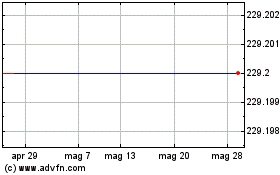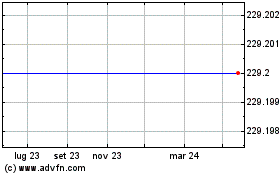Roche IL-6 is the first immunoassay approved to aid sepsis diagnosis in newborns
18 Ottobre 2023 - 7:03AM

Roche IL-6 is the first immunoassay approved to aid sepsis
diagnosis in newborns
- Neonatal sepsis is a
leading cause of death for newborns
- Testing IL-6 can indicate a
neonatal sepsis infection earlier than other
biomarkers
- Earlier diagnosis of
neonatal sepsis can lead to improved outcomes and a reduction of
long-term complications from sepsis
Basel, 18 October 2023 - Roche (SIX: RO, ROG; OTCQX: RHHBY)
announced today that the Elecsys IL-6 immunoassay has become the
first IL-6 test to have a certified claim for use in diagnosis of
neonatal sepsis, in countries accepting the CE Mark.*
Elecsys IL-6 aids physicians in combating the impact of neonatal
sepsis by facilitating an early diagnosis. Early and improved
diagnosis can contribute to appropriate use of antibiotics, as well
as potentially decreasing mortality rates and mitigating long-term
consequences of sepsis.
“Sepsis is one of the leading causes of death in newborns and we
need to do everything we can to prevent these deaths," said Matt
Sause, CEO of Roche Diagnostics. "Receiving the first approval for
IL-6 use with newborns, is a significant step forward in helping
clinicians confidently diagnose neonatal sepsis earlier and save
more lives.”
Neonatal sepsis is an infection involving the bloodstream within
the first four weeks of life and results in high rates of morbidity
and mortality. Neonatal sepsis can initially present with subtle
signs, but can rapidly progress to multisystem organ failure. Early
detection and prompt intervention are essential to prevent severe
and life-threatening complications.
Testing IL-6 is suitable for early diagnosis of neonatal sepsis
as it increases rapidly in response to infection, much earlier than
other markers, making it a better early warning marker of
inflammation, infection, or sepsis. With earlier diagnosis,
clinicians can make earlier and more appropriate interventions to
give neonates the best chance of a positive outcome. The Elecsys
IL-6 can help to achieve this with the test only taking 18 minutes
to run and only using a small amount of blood.
About neonatal sepsisSepsis is a condition that
can be caused by bacteria, fungi or viruses in the blood and is the
result of the body’s response to infection. Sepsis is defined as
life-threatening organ dysfunction caused by a dysregulated host
response to infection. 20% of deaths worldwide are sepsis-related
and patient survival decreases by ~8% with each hour of delay
before effective treatment.
The first 28 days of life (the neonatal period) are the most
vulnerable time for child survival. Every year, an estimated 2.5
million neonates die in their first month of life, accounting for
nearly one-half of deaths in children under 5 years of age. An
estimated 375 000 neonatal deaths due to sepsis occurred globally
in 2018, which represented 15% of all neonatal deaths, making
sepsis one of the leading causes of newborn death.
Newborns often present with non-specific signs and symptoms,
which means an early diagnosis of neonatal sepsis can be difficult.
Some laboratory tests used in sepsis diagnosis have a low
sensitivity, particularly in the early phase of infection. It is
also difficult to collect sufficient blood volumes from neonates,
especially low birthweight infants, so using a small sample size is
important to be minimally invasive to the baby. If a sufficient
blood sample cannot be taken, it may lead to low positivity rate in
blood cultures. In addition, blood culture results can take up to
48 hours, therefore treatment is often started before results are
known.
The prognosis of neonatal sepsis depends on early recognition
and appropriate treatment, although signs and symptoms are often
nonspecific and may overlap with those of other severe conditions,
such as meningitis and pneumonia. These clinical signs include
respiratory distress and cyanosis, apnoea, feeding difficulties,
lethargy or irritability, and poor perfusion.
About Elecsys IL-6Elecsys IL-6 immunoassay is
an in vitro diagnostic test for the quantitative determination of
IL-6 (interleukin-6) in human serum and plasma. This assay is used
to assist in identifying severe inflammatory responses in patients.
A test takes 18 minutes to run and only needs a sample volume of 30
μL (cobas® e411, e601, e602); or 18 μL (cobas® e402, e801), one of
the smallest volumes on the market. The Elecsys IL-6 immunoassay is
an electrochemiluminescence immunoassay “ECLIA” and is intended for
use on cobas e immunoassay analyzers.About
Roche Founded in 1896 in Basel, Switzerland, as one of the
first industrial manufacturers of branded medicines, Roche has
grown into the world’s largest biotechnology company and the global
leader in in-vitro diagnostics. The company pursues scientific
excellence to discover and develop medicines and diagnostics for
improving and saving the lives of people around the world. We are a
pioneer in personalised healthcare and want to further transform
how healthcare is delivered to have an even greater impact. To
provide the best care for each person we partner with many
stakeholders and combine our strengths in Diagnostics and Pharma
with data insights from the clinical practice.
In recognising our endeavour to pursue a long-term perspective
in all we do, Roche has been named one of the most sustainable
companies in the pharmaceuticals industry by the Dow Jones
Sustainability Indices for the thirteenth consecutive year. This
distinction also reflects our efforts to improve access to
healthcare together with local partners in every country we
work.
Genentech, in the United States, is a wholly owned member of the
Roche Group. Roche is the majority shareholder in Chugai
Pharmaceutical, Japan.
For more information, please visit www.roche.com.
*The claim certification is supported by an
investigator-initiated study (IIS) from the Medical University of
Vienna, evaluating ~8500 Elecsys IL-6 measurements from 1695
neonates. Elecsys IL-6 demonstrated excellent performance for the
detection of neonatal sepsis. AUC = 0.92 (95% CI: 0.89–0.94),
Global specificity 88% (95% CI: 83–92%), Global sensitivity 82%
(95% CI: 77–86%)
All trademarks used or mentioned in this release are protected
by law.
Roche Global Media Relations
Phone: +41 61 688 8888 / e-mail: media.relations@roche.com
|
Hans Trees, PhDPhone: +41 79 407
72 58 |
Nathalie
AltermattPhone: +41 79 771 05 25 |
| Simon
GoldsboroughPhone: +44 797 32 72 915 |
Karsten
KleinePhone: +41 79 461 86 83 |
| Nina
MählitzPhone: +41 79 327 54 74 |
Kirti
PandeyPhone: +49 172 6367262 |
| Rebekka
SchnellPhone: +41 79 205 27 03 |
Sileia
UrechPhone: +41 79 935 81 48 |
Roche Investor Relations
| Dr. Bruno
Eschli Phone: +41 61 68-75284 e-mail:
bruno.eschli@roche.com |
Dr.
Sabine BorngräberPhone: +41 61 68-88027 e-mail:
sabine.borngraeber@roche.com |
| Dr.
Birgit MasjostPhone: +41 61 68-84814e-mail:
birgit.masjost@roche.com |
Dr.
Gerard Tobin Phone: +41 61 68-72942 e-mail:
gerard.tobin@roche.com |
Investor Relations North America
| Loren
KalmPhone: +1 650 225 3217 e-mail:
kalm.loren@gene.com |
- 18102023_MR_IL-6_immunoassay_en
Grafico Azioni Roche (LSE:0QQ6)
Storico
Da Apr 2024 a Mag 2024

Grafico Azioni Roche (LSE:0QQ6)
Storico
Da Mag 2023 a Mag 2024
